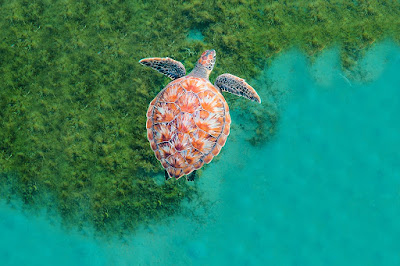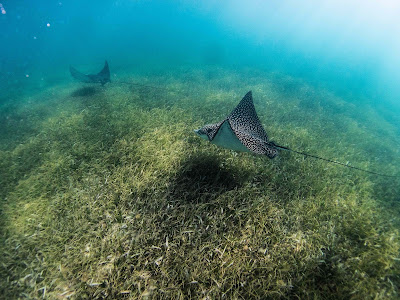The Secret World of Seagrass Meadows
Countless marvelous marine critters live in seagrass meadows which are easily seen in places like the Buccoo Reef marine protected area in Tobago. Dr Anjani Ganase encourages us to learn about their connections to reef and mangrove, and to allow the children to explore them.
Seagrasses are the only flowering plants that grow in the marine environment. Let that sink in for a second: a flowering plant adapted to living underwater in the ocean! They are commonly found in shallow sheltered waters along coastal areas. Though widely distributed along shallow coastal areas that are connected to about one billion people from the tropics to the poles, the actual acreage of seagrass is less than one percent of the ocean (the size of The Philippines). Yet in the narrow shallow zones between the land and the open ocean, the seagrass habitats provide special ecological functions to the ocean and to us. Unfortunately, seagrass communities around the world are declining at alarming rate. Since the 1930s about 7 % of the habitat is lost annually, equivalent to one football field every thirty minutes (UNEP). The primary driver of this loss is the result of coastal development resulting in seagrasses being smothered by sedimentation and pollution.
As seagrasses are flowering plants, they depend on water movement to pollinate their flowers, but they also grow by spreading runners along the sand. While water movement may be a primary source of pollination, marine pollinators, mainly microfauna, also play the roles of the “bees of the sea” and move among the flowers when searching for food. Seagrass meadows form a vast interconnected complex of habitats for an array of marine organisms. They house incredible biodiversity and serve as a nursery for juvenile fish and shellfish. When connected with coral reefs and mangroves, the intertwined ecosystem forms a biodiversity hotspot of residential and visitor marine life. Here are some examples of how the ocean and humans benefit from seagrasses.

Green sea turtle over
seagrass, Saint-Pierre, Martinique Credit: Michele Roux / Ocean Image Bank
Seagrasses and climate change:
Seagrass meadows are valuable carbon sequestrators and therefore their conservation is an essential consideration for countries targeting the reduction of carbon emissions. The annual loss of seagrass is equivalent to about 0.65 gigatons of carbon dioxide emissions per year and roughly equates to the yearly emissions from the entire global shipping industry (Hoegh-Guldberg et al. 2018). Their rapid growth rates make them suitable for coastal restoration and adaptation to sea-level rise if protected.

Eagle Rays in seagrass
(Thalassia testudinum), Quintana Roo, Mexico Credit: Ben Jones /
Ocean Image Bank
Seagrasses purify the water:
Seagrasses can purify the water in multiple ways. Firstly, seagrasses dampen water movement and encourage the settlement of fine particulates (once it is not an overwhelming amount from land clearing, soil erosion or from sediment relocation during a storm). Secondly, seagrasses can absorb excess nutrient pollutants that enter the water column from sewerage run off or agricultural lands that would typically result in algae and microbial blooms which make the water column murky and resulting in diseases. Additionally, research has shown that seagrasses have natural biocides and biofilms that inhibit bacterial pathogen abundance in the surrounding environment. Water samples associated with seagrass meadows have three-times lower concentration of enterococci bacteria compared to non-seagrass sites. This type of bacteria can be pathogenic to both humans and marine organisms. Furthermore, on coral reefs adjacent to seagrass areas, the concentrations of enterococci were two times lower and there was also a lower prevalence of coral diseases compared to coral reefs not associated with seagrass meadows.
Credit: Michiel
Vos / Ocean Image Bank 
Seagrass with a Green Shore
crab (Carcinus maenas), Isles of Scilly, Cornwall, UK
Seagrasses as part of a marine complex
Seagrass meadows on their own provide considerable functional support to marine and human communities, but when they associate with other marine ecosystems – coral reefs and mangroves - they become a super ecosystem owing to their connectivity and complimentary ecological services. Seagrass meadows associated with mangroves and coral reefs have considerably higher biodiversity and nursery capacity, considering the high variations in the types of marine habitats and the substantial exchange of organisms and nutrients. Combined, they also contribute to coastal stabilization and protection by dampening water movement. Seagrass and mangroves together sequestrate and create a major carbon sink for the area. Because they support adjacent ecosystems and provide these benefits to each other, such buffers make them more resilient to disturbances in a marine complex.

Leafy Seadragon, South
Australia Credit: Jayne Jenkins / Ocean Image Bank
Seagrass unique biodiversity:
The structure of seagrasses provides micro-habitats for an array to residential and visiting marine life. Many fish species use seagrasses as a nursery in which the juveniles are protected, and food is easily accessible. Seagrasses are home to a lot of cryptic crustaceans, such as crabs, lobster, conch, sea stars and sea urchins. Many of these critters either feed on the seagrass blades or on the algae and biofilms that grow on the blades. When you explore a seagrass meadow, be sure to grab a mask and snorkel and just drift over the surface of the seagrass. It is easy to get a close view of the tiny marine world of seagrass critters. If you’re in luck though you may also encounter the larger marine creatures that feed on the seagrass inhabitants. Green turtles are a major forager of seagrasses, but you may also spy a loggerhead, a stingray, or a nurse shark on the hunt for some tasty crustaceans. Other users of seagrass meadows are octopuses, squid, cuttlefish and seahorses, all well capable of camouflaging themselves for the hunt. These creatures may need well trained eyes, but the more you explore, the more you will discover.

Mangroves meet seagrass in
Raja Ampat, Indonesia. Credit: The Ocean Agency / Ocean Image Bank
References
United Nations Environment Programme (2020). Out of the blue: The value of seagrasses to the environment and to people. UNEP, Nairobi.
Lamb, Joleah B., et al. "Seagrass ecosystems reduce exposure to bacterial pathogens of humans, fishes, and invertebrates." Science 355.6326 (2017): 731-733.
Van Tussenbroek, Brigitta I., et al. "Experimental evidence of pollination in marine flowers by invertebrate fauna." Nature communications 7.1 (2016): 1-6.


